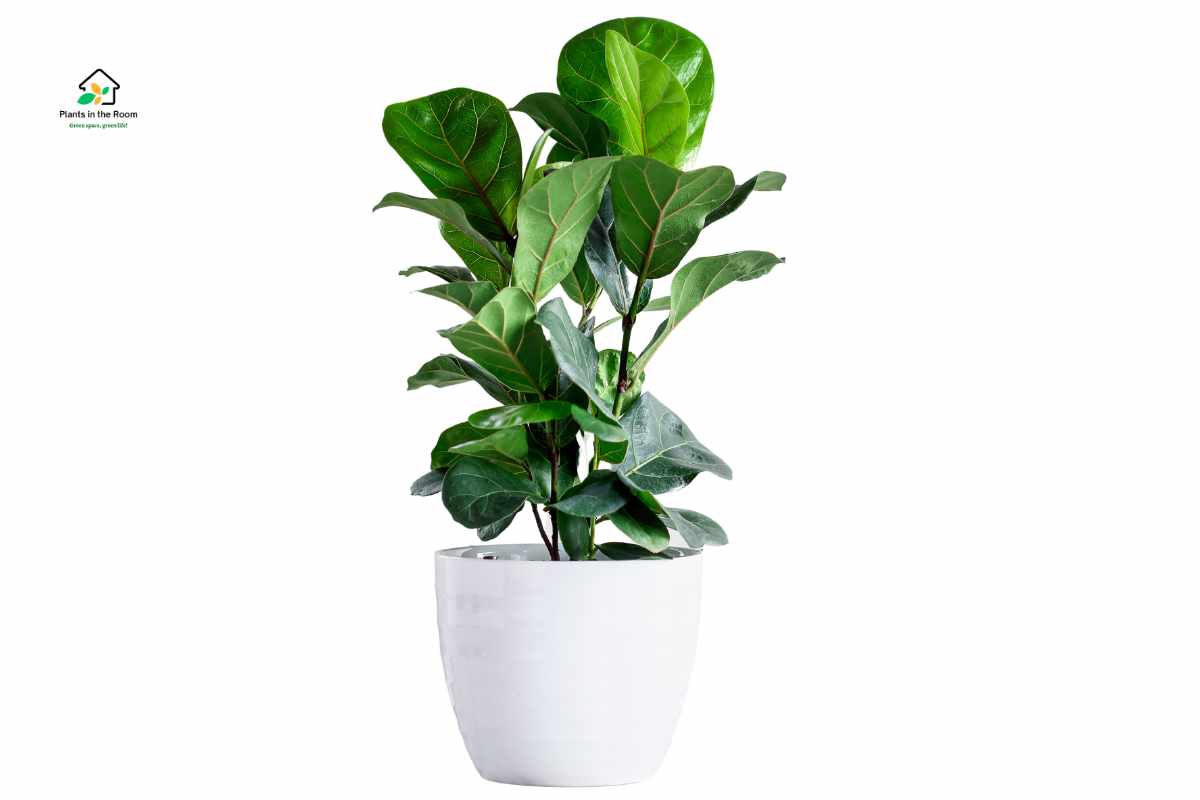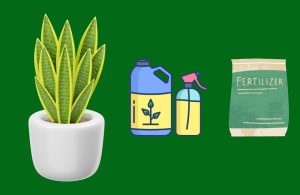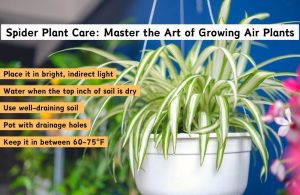This article covers the following areas –
- Understanding Your Fiddle Leaf Fig
- Lighting
- Watering
- Humidity
- Temperature
- Fertilizing
- Pruning
- Repotting
- Common Problems and Solutions
- In Conclusion
- Get to Know Your Fiddle Leaf Fig
I have always been fascinated by the Fiddle Leaf Fig, as it is a great addition to any indoor space. However, they require a little extra care and attention to keep them healthy and looking their best. In this post, I’ll share some basic tips and tricks for Fiddle Leaf Fig care that I have learned over the years.
Place your Fiddle Leaf Fig in bright, indirect light and keep the temperature between 60-75°F. Water consistently & Fertilize every 4-6 weeks with a balanced liquid fertilizer. Also, watch out for pests like spider mites and scale insects and diseases such as root rot and bacterial blight to ensure proper care.
Well! Now, let’s learn everything related to Fiddle Leaf Fig care in more detail. Keep reading for the tips to ensure the best care of your houseplant.
Understanding Your Fiddle Leaf Fig
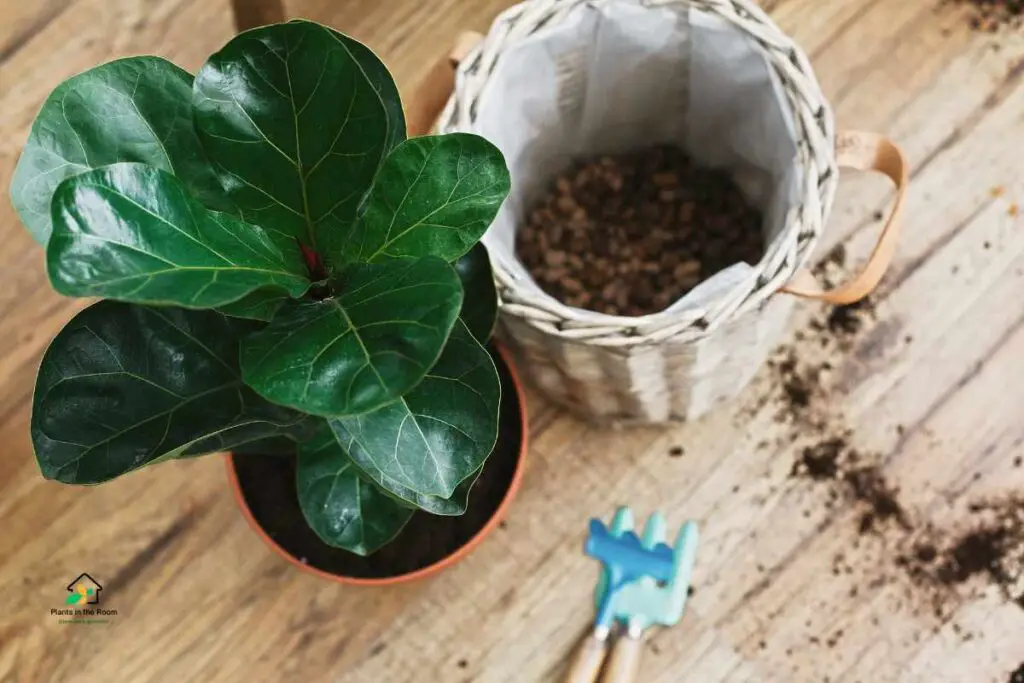
Before we get into the specifics of Fiddle Leaf Fig care, it’s important to understand a few basic things about the plant itself. Fiddle Leaf Figs (Ficus lyrata) are native to the rainforests of West Africa and can grow up to 40 feet tall in their natural habitat.
Indoors, they typically reach a height of 6 to 10 feet. They have large, glossy leaves that can measure up to 18 inches long and 12 inches wide.
Fiddle Leaf Figs are sensitive to changes in their environment, which means they require a bit more care than some other houseplants. But with the right conditions, they can thrive and become a stunning focal point in any room.
Lighting
Your Fiddle Leaf Fig needs bright, indirect light to grow and thrive. Direct sunlight can scorch their leaves, so it’s best to place them near a north or east-facing window where they can get plenty of bright, filtered light.
If your Fiddle Leaf Fig isn’t getting enough light, you may notice its leaves turning yellow and dropping off. On the other hand, if it’s getting too much light, you may notice brown spots or burned patches on the leaves.
Watering
Another important aspect of Fiddle Leaf Fig care is watering. These plants like to be kept consistently moist, but they don’t like to be overwatered. Overwatering can cause root rot, which can be fatal for your plant.
To water your Fiddle Leaf Fig, check the soil with your finger. If the top inch of soil feels dry, it’s time to water. When you water, be sure to water thoroughly, allowing the excess water to drain out the bottom of the pot. Avoid letting your Fiddle Leaf Fig sit in standing water, as this can also lead to root rot.
Humidity
Fiddle Leaf Figs are native to a humid environment, so they appreciate higher humidity levels indoors. If the air in your home is dry, you may notice your plant’s leaves turning brown at the edges or becoming dry and brittle. To increase the humidity around your Fiddle Leaf Fig, you can:
- Mist the leaves regularly with a spray bottle filled with water.
- Place a small humidifier near your plant.
- Set your plant on a tray filled with pebbles and water. Be sure the water level is below the surface of the pebbles so the pot doesn’t sit in standing water.
Temperature
Fiddle Leaf Figs prefer a warm, consistent environment. They don’t like cold drafts or sudden temperature changes. Keep your plant away from windows or doors that may let in cold air, and try to maintain a temperature between 60 and 75 degrees Fahrenheit.
Fertilizing
When choosing a fertilizer, look for a balanced, water-soluble formula with an equal ratio of nitrogen, phosphorus, and potassium (such as 10-10-10 or 20-20-20). This will provide your plant with the essential nutrients it needs to grow healthy leaves and strong stems. Follow the instructions on the package carefully, as over-fertilizing can cause burned leaves or other problems.
To apply the fertilizer, dilute it to half strength and water your plant as you normally would. Alternatively, you can apply the fertilizer directly to the soil and then water the plant to distribute it evenly. Remember to fertilize only during the growing season and avoid fertilizing during the fall and winter months when the plant is dormant.
By fertilizing your Fiddle Leaf Fig regularly, you can ensure that it has the nutrients it needs to grow and produce its signature large, glossy leaves. A healthy, well-fed plant will also be more resistant to pests and diseases, making it easier to care for in the long run.
Pruning
Pruning helps to keep your Fiddle Leaf Fig healthy and looking its best. Pruning can also help to control the size and shape of your plant, as Fiddle Leaf Figs can grow quite large if left unchecked.
To prune your Fiddle Leaf Fig, use a pair of sharp, clean shears to cut back any dead, damaged, or yellowing leaves. You can also prune back any leggy or straggly growth to encourage a fuller, bushier plant.
Be sure to make clean cuts close to the stem, and avoid leaving stubs that can attract pests or disease.
Repotting
Fiddle Leaf Figs prefer to be slightly root-bound, so they don’t need to be repotted very often. However, if your plant has outgrown its current pot or the soil is becoming compacted and dry, it may be time to repot.
To repot your Fiddle Leaf Fig, start by choosing a pot that is only slightly larger than its current pot. This will help prevent the soil from becoming too moist and will provide adequate space for the plant’s roots to grow.
Use a high-quality potting soil that drains well, and be sure to add a layer of drainage material (such as rocks or gravel) at the bottom of the pot to prevent water from accumulating in the bottom of the pot.
Gently remove your plant from its current pot and loosen any tangled roots. Be careful not to damage the roots during this process. If the roots are particularly tangled, you can use a sharp knife or pruning shears to make small cuts and separate them.
Once the roots are untangled, place your plant in the new pot, filling in around the roots with fresh soil. Be sure to leave some space at the top of the pot to allow for watering.
Water your plant thoroughly after repotting, and give it some time to adjust to its new surroundings. You may notice some leaf drop or wilting initially, but this is normal and should resolve on its own as the plant adjusts to its new environment.
Common Problems and Solutions
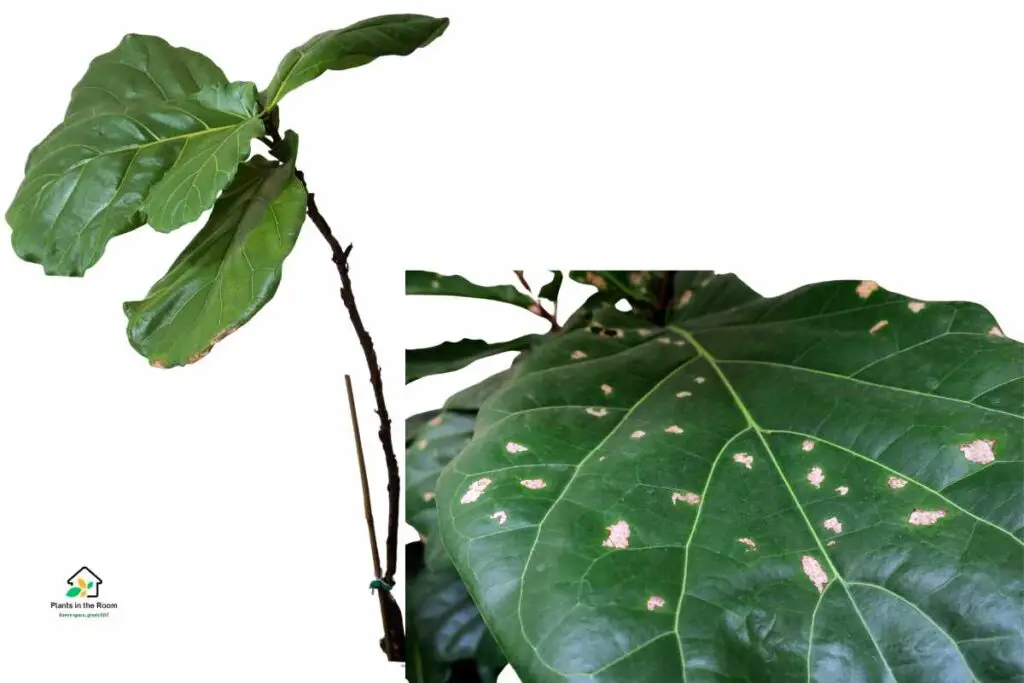
Even with the best care, Fiddle Leaf Figs can sometimes run into problems. Here are some common issues you may encounter and how to address them.
#1 Brown Spots on Leaves
If you notice brown spots on your Fiddle Leaf Fig leaves, it could be a sign of overwatering, underwatering, or too much direct sunlight. Adjust your watering and lighting as needed, and trim off any damaged leaves to prevent further damage.
#2 Yellow Leaves
Yellowing leaves can be caused by a variety of factors, including too much or too little water, poor lighting, or a lack of nutrients. Check your watering and lighting, and consider fertilizing your plant with a balanced fertilizer to provide it with the nutrients it needs.
#3 Leaf Drop
Fiddle Leaf Figs can drop leaves due to changes in environment, such as moving your plant to a new location, or over or underwatering. Pests can also cause leaf drop. Check your watering and lighting, inspect your plant for pests, and treat as needed.
#4 Pests
Fiddle Leaf Figs are susceptible to pests such as spider mites, mealybugs, and scale insects. Inspect your plant regularly for signs of infestation, such as webbing, sticky residue, or tiny insects on the leaves. Treat any pests promptly with a mild insecticidal soap or neem oil, being sure to follow the instructions on the label.
By addressing these problems early and taking steps to prevent them from occurring in the first place, you can keep your Fiddle Leaf Fig healthy and beautiful for years to come. Regular care, including proper watering, fertilizing, and pest control, can go a long way in keeping your plant looking its best.
In Conclusion
Fiddle Leaf Fig care can seem intimidating at first, but with a little knowledge and effort, these plants can thrive and become a beautiful addition to your indoor space. I hope the tips I’ve provided here will help you to ensure the best care for a healthy plant.
Get to Know Your Fiddle Leaf Fig
| Indicator | Fiddle Leaf Fig (Ficus lyrata) |
|---|---|
| Family | Moraceae |
| Genus | Ficus |
| Common Name | Fiddle Leaf Fig |
| Origin | West Africa |
| Plant Type | Evergreen, Tree |
| Mature Size | Up to 40 feet (12 meters) in height, 6-10 feet (2-3 meters) indoors |
| Growth Rate | Moderate |
| Light Requirements | Bright, Indirect Light |
| Watering Requirements | Consistently moist, Allow top inch of soil to dry before watering |
| Soil Preference | Well-draining, Rich soil mix |
| Temperature Tolerance | 60-75°F (16-24°C) |
| Humidity Tolerance | High Humidity (50-60%) |
| Fertilization | Every 4-6 weeks during the growing season, Balanced liquid fertilizer |
| Propagation | Air layering, Stem Cuttings |
| Pests | Spider Mites, Mealybugs, Scale Insects |
| Diseases | Root Rot, Leaf Spot, Bacterial Blight |
| Toxicity | Toxic to humans and pets if ingested |
| Special Features | Large, Glossy Leaves, Statement Plant |
| Popular Uses | Indoor Decoration, Focal Point Plant, Statement Plant |
What do you think of these Fiddle Leaf Fig care tips? Do you have any additional tips or tricks for keeping these plants healthy? Have you encountered any problems with your Fiddle Leaf Fig, and if so, how did you address them? I’d love to hear from you in the comments below!

